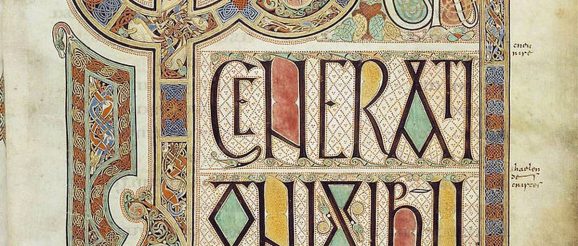A golden age of design, craftsmanship and literary innovation: Paul Clements on the Lindisfarne Gospels – The Irish Times

Few people who visit fail to be affected by its deeply atmospheric nature and Lindisfarne, or Holy Island, on the rugged coastline of Northumberland is filled with a spiritual magnetism. For those who choose to walk barefoot across the arrow-straight causeway following a line of poles it is a serene place of pilgrimage – provided you have determined the correct tide times for a safe crossing.
On a regular basis visitors and vehicles are rescued after becoming stranded on the tidal causeway. Coastguard teams and the inshore lifeboat are called out to help motorists stuck at high tide who have climbed up to the safety of the refuge box; often as not, depending on the level of saltwater ingress, their car is a write-off.
Lindisfarne has a fascinating religious, military, cultural and natural history. When the Kingdom of Northumbria was ruled by Oswald he met Irish monks from Iona, including St Aidan, inviting them to settle on the island in AD 535. They established a monastery on the Irish pattern, thought to be a wooden church, with huts and a large communal building. Aidan was the first inhabitant whose name is known but he was eclipsed by St Cuthbert, who became Prior of Lindisfarne and was buried there in 687. Famed for his piety and healing powers, his name is synonymous with the island.
The cult of Cuthbert inspired one of the world’s most renowned books – the richly decorated Lindisfarne Gospels created at the priory and representing a golden age of design, craftsmanship and literary innovation. The Gospels are thought to have been made around 715-720 when Eadfrith, Bishop of Lindisfarne then at the peak of his powers, began working on sheets of vellum made from cowhide. Vellum comes from velin, an old French word for a calf, and the book required the skins of more than 100 calves.
Eadfrith produced the intricate Latin transcript of an illuminated copy of the four Gospels dedicated to St Cuthbert who had been forced to flee the island in 793 following Viking raids. He used a script known as insular majuscule, first developed in Ireland, which came to Lindisfarne with Aidan. The Gospels later went to Durham Cathedral, built to house the body of Cuthbert, and in the 10th century a priest named Aldred added the earliest surviving Anglo-Saxon translation in between the lines of Latin text.
Fashioned when there was a thirst for knowledge at a time of flourishing arts, the book is a symbol of cultural identity with its distinctive iconography and the precision of its intricate design. Normally housed in the British Library in London, it has survived in almost perfect condition for over 1,000 years. Now for the first time in more than seven years it is temporarily coming home to its roots, returning to the north-east of England where it will be displayed in the Laing Art Gallery, Newcastle upon Tyne, until December 3rd. The idea behind this is to allow people outside London to see the manuscript at first hand. But just one section of this precious relic will be on display covering two pages, although a replica is permanently in the Lindisfarne Centre on the island.
The Lindisfarne Gospels, which established the shape of modern books, have inspired artists throughout the centuries. A gallery exhibition on its significance today examines its relationship with themes of identity through events and workshops as well as film, light and soundscape installations. Paintings, drawings and photographs consider how art and spirituality have developed since the book was made.
St Cuthbert reputedly offered sanctuary to eider ducks on the nearby Farne Islands in the North Sea and that association survives in their traditional local names of “Cuthbert duck” and “Cuddy duck”. But for today’s visiting ornithologists there is sadness attached to these small uninhabited islands as currently they are off limits to landing parties. In an attempt to reduce the spread of avian influenza which has had a devastating effect on the seabird population, people have been asked not to visit the archipelago. The virus has killed at least 3,000 birds on the cluster of islands and has had a serious effect on roseate terns on Coquet Island.
Lindisfarne itself, though, remains a vibrant community open for business. Aside from the 13th century priory with its red sandstone walls, pillars and rainbow arch, there is much to explore for antiquarians, historians, ramblers and those with just a plain curiosity. Wander around the axe-shaped island crossing its pristine bays, shimmering sands and dunes and admire where the land and the sea meet huge skies. Catch the right day, sip a glass of mead or Holy Island rum, and as you drink in the chiaroscuro of light around the Heugh or across the Crooked Lonnen, the austere beauty will remain long in your memory. www.laingartgallery.org.uk
